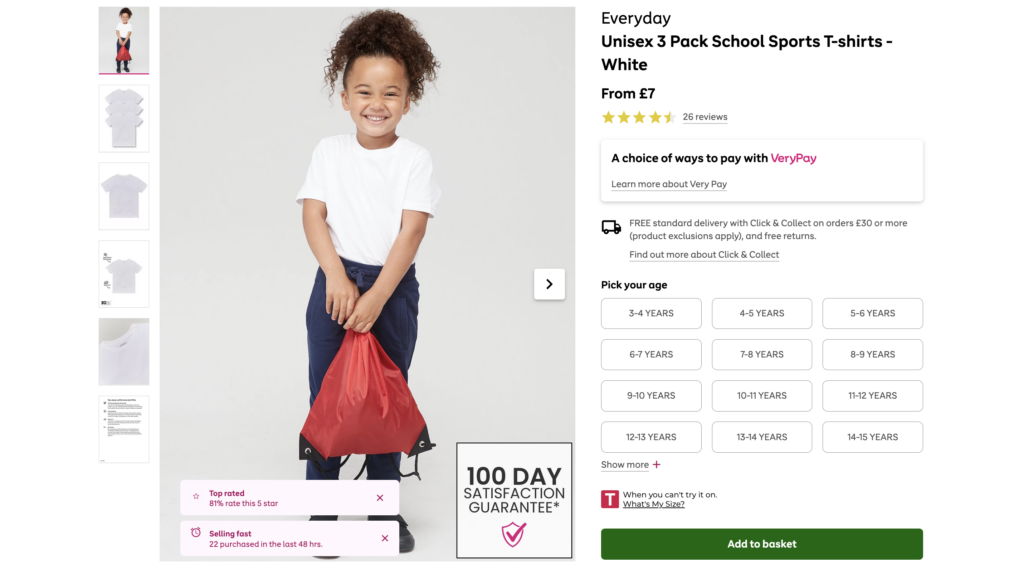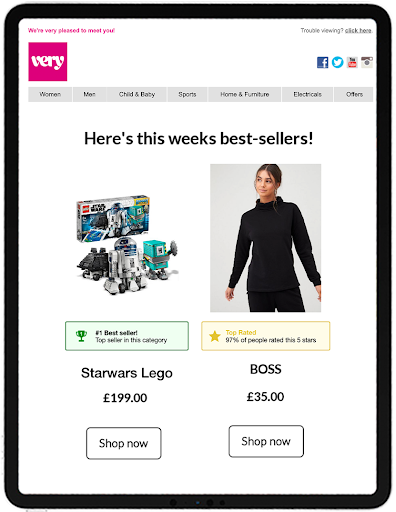As we approach peak season, consumers will start filling their online shopping baskets with gifts for family and friends. But as joyful as it is to see a loved one open that perfect gift, gift shopping can be equally stressful and overwhelming, even with a wishlist in hand. Despite our best efforts, a high percentage of gifts are returned. In the US, UPS even started calling January 2nd “Peak Returns Day” because they typically see a significant increase in returns at that time of year.
But high return rates are not just a seasonal problem. Returns from eCommerce orders in the UK alone reached £4.2 billion in 2023. The average eCommerce return rate falls somewhere between 20-30% depending on category, compared to 9% for brick-and-mortar purchases.
When factoring in the impact on the entire business, including shipping, warehousing, customer service and product damage, the average cost for the retailer for a single return is $25-$30.
That’s a hard hit on a retailer’s bottom line.
eCommerce returns are inevitable, but there are ways to tackle high return rates upfront by optimising the overall digital experience and helping shoppers make more informed purchase decisions.
Why do customers return eCommerce orders, and how do retailers typically respond
Before we dive into ways to reduce high return rates, let’s take a quick look at why customers return eCommerce purchases in the first place. Here are a few of the most common reasons:
- Issues with sizing and fit
- Poor product quality and defects
- Changed their mind
- Received the wrong item
- Purchased with the intent to return
- Order didn’t arrive on time
- Returning a gift
There are many other factors that cause customers to return online orders, and luckily, there are many ways to optimise the shopping experience to minimise returns. However, no matter how informed and certain a customer is before hitting the buy button, returns are unavoidable, and how a retailer handles the return experience matters.
Not long ago, as eCommerce gained popularity, retailers started to ease return policies in response to customer demands and to gain competitive advantage. Year-long return windows and free return shipping became commonplace, especially with larger retailers. However, these liberal return policies proved too costly in the long run, and retailers are now rethinking their return strategies.
Many have shortened return windows and no longer offer free online returns, charging customers for return shipping. Others have completely eliminated refunds and only offer exchanges or store credit. Some step in even earlier in the customer journey with creative strategies to circumvent returns, including incentives for not returning an item or even blacklisting customers that return goods too frequently.
But with peak season just around the corner, retailers and brands should try to do everything in their power to reduce return rates in the first place.
Strategies for optimising your digital experience to reduce eCommerce returns
When purchasing a product online, shoppers rely on you to provide detailed product descriptions, accurate specifications and quality photos to help them make a purchase decision. They also rely on customer reviews and recommendations and digital tools to guide them to the right product.
It all comes down to helping customers make more informed purchase decisions. If you can successfully weave content, guided tools and experiences into their shopping journey, you can reduce the likelihood of them purchasing a product that doesn’t meet their expectations.
Detailed and accurate product descriptions
One of the main reasons eCommerce returns occur is when the product is different in reality than how it was described on the eCommerce site. The easiest way to overcome this is by ensuring that your product detail pages (PDP) are as detailed and accurate as possible, allowing shoppers to visualise and assess if a product is the right choice for them.
Detailed product descriptions can also address a customer’s potential questions and concerns about a product. The PDP should include a description of the product, specifications, measurements, and materials used.
There is a risk of providing too much information, though. You don’t want your most important product details to be buried on the page or for shoppers to suffer from information overload, which can lead to decision paralysis. Design and page structure matter, as do technologies that will help bump and elevate content that the shopper needs most to make an informed decision.
Retailers like N Brown use social proof and attribute messaging to highlight and bring key product attributes, like sustainability or materials information, above the fold. This helps shoppers easily find the information that matters to them when making a decision.

High-quality images and videos
The importance of high-quality images sounds like a no-brainer, but too many brands still take shortcuts when it comes to product photography. Great visuals clearly showcase a product’s features, design, and quality. This is especially important in eCommerce, where shoppers cannot feel or experience the product in real life.
Provide shoppers with a range of product images that showcase a product from multiple angles with zoom capabilities and in a variety of scenarios. Use videos to show the product in use to ensure that customers understand exactly what they are getting.
These visual tools will improve conversion rates and also help to avoid surprises and disappointment when the customer opens the package at home.
Customer ratings & reviews
While shoppers rely on what you share about your products through product descriptions and images, they will value and trust what your customers say even more. Customer product reviews offer insights from real customers, good and bad, making them more trustworthy and critical in helping shoppers make better purchase decisions.
However, as ratings and reviews have become more mainstream, the customer experience sometimes becomes more confusing than helpful. Retailers can improve reviews and ratings by introducing review summaries, filters to help shoppers find the reviews that are most relevant to them and customer photos and videos.
Retailers can also elevate reviews by integrating aggregated review data with social proof messaging. This will bring the most relevant information front and centre, with messaging such as “95% said true to size” or “87% rated this 5 stars.”

In addition to improving the customer experience, insights from customer reviews can also help retailers refine products and prioritise strategies to reduce product returns and improve return processes.
Fit and sizing tools
Helping shoppers find the right match will reduce the number of items returned because they got the wrong size or fit.
This can be done with enhanced sizing charts that include detailed measurements and photos that show a product on different models or in different contexts and scenarios to help shoppers determine the right size. This is especially relevant in apparel and footwear, with average return rates for online apparel brands around 33%.
Interactive quizzes that compare sizing to other known brands or help shoppers narrow down products, such as skincare products, are great ways to help shoppers make better purchase decisions. Retailers can also combine social proof messaging and reviews about fit to help shoppers find the right size.
Some retailers, especially in the beauty and home industries, use augmented reality (AR) and virtual reality (VR) tools to help shoppers experience what a product will look like on them or in their space. This results in confident purchasing decisions and reduces the likelihood of returning items that don’t meet their expectations.
Real-time, live expert advice
Another way to reduce return rates is to provide online shoppers with easy and convenient access to expert help via live chat or SMS.
This allows them to ask questions, learn more about products, and get recommendations before making a decision. These expert conversations help shoppers find the right fit and the right gift and help them determine if your product will meet their expectations.
Retailers can start by educating and empowering customer service to answer product questions directly. There are solutions and services that provide excellent concierge services to facilitate these expert communications.
Post-purchase support and reinforcement
Finally, while shoppers might feel confident when making the online purchase, you can avoid buyer remorse by providing post-purchase support to answer questions about how to get the most out of their product and how to style it and inviting them to leave reviews on your site.
Include social proof messaging in post-purchase communication to bolster customers’ confidence that they have made the right decision. Remind customers that others bought the same product and loved it.

Get in front of high eCommerce Returns with Social Proof
Even with the best strategies in place, there will still be times when a customer will return a product. You can turn those moments into brand-building opportunities by delivering an exceptional return experience that is easy, transparent and convenient.
But even if returns are inevitable, there are ways to proactively reduce returns by focusing on optimising the customer experience and helping shoppers make better purchase decisions in the first place.
Contact Taggstar today to learn how social proof and attribute messaging can be implemented today to help you make the most of the peak season and minimise the return damage to your bottom line.



